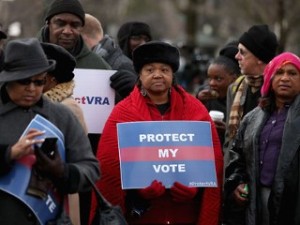Dismantling Voting Rights Part II: Implications of Shelby County

“I disagree with the court that the history of discrimination is somehow irrelevant today. The record clearly demonstrates numerous attempts to impede voting rights still exist, and it does not matter that those attempts are not as “pervasive, widespread or rampant” as they were in 1965. One instance of discrimination is too much in a democracy.” — Congressman John Lewis
The Voting Rights Act (“VRA”) marked the death knell for the traditional means of voter disenfranchisement, particularly literacy tests and poll taxes. Two years after Congress passed the VRA, the number of African-American registered voters jumped almost 18% in Southern States.[1] By the late 1980s, registration rates in Alabama increased from a pre-VRA 19.3% to 68.4%; in Mississippi, registration rates grew nearly 70%, from 6.7% in March of 1965 to 74.2% in November of 1988. The number of African-American representatives similarly saw a mass increase. In 1967, Edward William Brooke III became the first African-American politician elected to the Senate since the end of Reconstruction. While in 1964, no African-Americans served in Southern legislatures, by 1974 – less than ten years after the VRA’s enactment – this number grew to approximately 100, and today Southern states have 313 African-American state legislators. The 2012 election marked the first time in history when African-Americans voter turn-out rates surpassed that of white voters.
These promising statistics do not, however, imply that the VRA’s objective is achieved. While the 113th Congress may be the most diverse in history, the percentage of minority representatives (slightly less than a third of the House) falls short of national demographics. Latinos particularly are underrepresented in Congress; while in 2012, 16.9% of the American population identified as Hispanic or Latino, only 7% of Congress identifies as Hispanic or Latino. Further, efforts at disenfranchisement of minority voters persist. In 2011, for example, the City of Natchez, Mississippi, attempted to institute a redistricting plan aimed at reducing the African-American population and therefore diluting voting strength in a particular ward. The Justice Department rejected the proposal, citing discriminatory intent. Just last year, the Justice Department blocked a Georgia state law that rescheduled local elections in Augusta-Richmond from November to July, a month with lower voter turnout particularly among minorities. These are just two examples of the myriad times the Justice Department has protected voting rights under the VRA.
With the recent holding in Shelby County v. Holder, however, the ability to combat voter discrimination under the VRA lies in doubt. This decision’s evisceration of the VRA comes at a time in which renewed attacks on voting rights run rampant, in the form of voter ID laws and redistricting plans. These 21st century iterations of legal voting repression place burdens disproportionately on young, poor, and minority voters and racially segregated voting districts. The Court’s move to rescind the VRA’s Section 4(b) allows states to proceed with blatantly discriminatory legislation previously blocked by the Justice Department under the VRA.
The demographics of America are rapidly changing, skewing younger and more racially diverse. This shift directly affects state and national politics and threatens Republican power. In the 2012 election, non-white voters overwhelmingly supported President Obama, as did voters 18-29 and those making under $50,000 per year. The growth of demographic groups that typically vote Democrat can drastically change the balance of political power, particularly in key battleground states. The increasing Latino population in Texas, for instance, could turn this Republican stronghold into hotly contested state within a decade.
The recent voter ID laws and redistricting plans work to directly counter the trends towards changing politics. In 2011, the Texas legislature passed a redistricting map that concentrated Latino and African-American populations into geographical districts while dispersing the white population, effectively decreasing the political power among minority voters. Similarly, Texas’ voter id law, blocked by the Justice Department until the Shelby County decision, disproportionately impacts the State’s Latino voters. In North Carolina, redistricting plans artificially divided predominately black communities, thereby diluting voting power among African-Americans, who overwhelmingly support Democratic candidates. North Carolina’s controversial voter ID law similarly suppresses African-American voting power.
Despite the blow Shelby County struck to the Justice Department’s ability to protect voting rights under the VRA, Attorney General Eric Holder continues to fight discriminatory laws. Shortly after the Court’s decision in Shelby County, Holder announced plans to challenge Texas’ redistricting plan and voter ID law. He has also filed suit to block North Carolina’s voter ID law. While the Justice Department may still utilize the Section 2 and Section 3 of the VRA, these provision require a higher burden of proof of discriminatory purpose than Section 5, leading to more protracted and expensive proceedings. Further, Section 2 litigation can occur only after enactment of offensive voting provisions. Thus, while Holder may still seek redress against voting wrongs under the VRA, he and other voting rights activists face an uphill battle.
“Our country has changed,” claimed Chief Justice Roberts in his Shelby County opinion. With this decision, the majority reasoned that because the VRA proved successful, it is time to relax the Act’s strict requirements. As Justice Ginsburg wrote in her dissent: “With that belief, and the argument derived from it, history repeats itself . . . the evolution of voting discrimination into more subtle second-generation barriers is powerful evidence that a remedy as effective as preclearance remains vital to protect minority voting rights and prevent backsliding.” The recent moves by state legislatures to implement voter ID laws and redistricting plans that deny rights particularly to minority voters make clear that change is relative. It is therefore essential that Congress rewrite and reauthorize the VRA to ensure that Shelby County does not usher in another era of mass voter disenfranchisement.
[1] Gerald N. Rosenberg, The Hollow Hope: Can Courts Bring About Social Change? 61 (2d ed. 2008).


This was a very thoughtful piece. Hopefully Roberts’ Shelby opinion won’t be the disaster it appears to be, but I’m not holding my breath.